Bluefin Tuna (Thunnus thynnus)
The Atlantic bluefin tuna is one of the most amazing fish in the world and belongs to the Scombridae family which includes Tunas and Mackerels. It is also referred to as Toro, Maguro, Giant Bluefin, Atlantic bonito, Maguro, hon-maguro, and Northern bluefin tuna. They are highly prized game fish for there large size, speed, strength and food quality. They have large streamline torpedo-shaped bodies similar to a football with retractable fins, a nearly circular midsection, and crescent tails reinforced by bony plates. The Atlantic bluefin can reach speeds of up to 50 miles per hour. The back has a dark blue almost black color and the sides and bottom are predominantly a silvery white color. The Atlantic Bluefin is the largest member of the Tuna family and can live up to 50 years. They can grow up to 1,496 lbs and reach up to 8.4 feet long. The world record was set by Captain Eric Samson aboard Lady and Misty on October 26, 1979 fishing out of Port Hood, Nova Scotia. It weighed an incredible 1,496 pounds and was over 8 feet long. The largest one ever caught in Florida was caught on May 2017 off of Destin, Florida and weighed a whopping 826-pounds and 8-ounces. They are warm-blooded fish that can tolerate either warm or cold waters. Although this fish is a great eating fish and worthy challenge for fisherman due to the high demand for o-toro sushi and advancements in commercial fishing technology they are becoming nearly extinct. The number of bluefin tunas in the western Atlantic has plunged by more than 90 percent since the 1970s, according to the International Commission for the Conservation of Atlantic Tunas. When fishing for Bluefin Tuna it is crucial to follow all rules and regulations to ensure the survival of these marvelous creatures. Going on a Florida fishing charter will greatly increase your odds of catching a Bluefin not to mention they are usually very knowledgeable with all the required fishing permits and regulations required
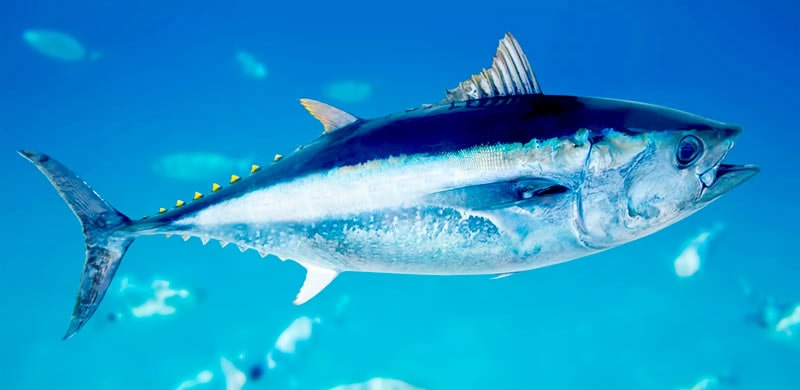
How to catch Bluefin Tuna in Miami
A giant bluefin tuna is one of the hardest fish to fight and land but if you’re lucky enough to find one here are some tips to catch these incredible fish. When fishing for bluefin tuna you want to use heavy tackle these fish have enormous strength. Using at least 70-pound braid with a 90-pound fluorocarbon leader attached to a 5/0 or 6/0 J-hook is recommended. Bluefin tuna have very good eyesight and are easily spooked by lines which make fluorocarbon leaders a necessity. Due to there incredible power, it is highly advised to have a chair or at least a harness close by. These fish can grow to massive sizes so having the right gear is essential to catching Bluefin Tuna in Florida. You want to have plenty of line on your rod they make very long runs and can spool your rod in the blink of an eye. The trick to catch Tuna once you spot them is to use the right bait. Live bait and trolling are the most common techniques for catching them but as with any fish live bait is king. If you find a good spot to fish for Bluefin but you don’t see any around you will want to start a live chum slick. A combination of boxed chum found in bait shops and cut up dead baits will help attract not only Bluefin Tuna but all sorts of large predators. You want to keep the chum slick live by throwing out pieces of dead bait consistently until they start to appear. The chum attracts schools of baitfish such as ballyhoo, google eyes and blue runners. If you’re drifting or anchored with live bait you want your bait to be sitting between 20 and 30 feet in the water column. Having multiple baits in the water at various depths will also improve your odds. Setting the hook is not required with these large fish as they will usually set it themselves while trying to get away. If you have any other lines in the water you want to reel in all the other rods to avoid getting tangled. Bringing up the anchor is also a good idea these fish tend to swim in circles under and around the boat when they get close, so bringing up the anchor will avoid them getting wrapped around it. Don’t try to reel these fish in right away let them take the line in order to get the fish tired and once you feel the fish is getting tired try bringing in some line. Keep the rod pointed down toward the fish and make sure to keep constant pressure on the line. Once the fish surfaces it is very likely that it will make a last attempt to spool your reel to get away. Having a gaff or harpoon nearby will help you to get the fish on the boat. If you’re trolling for Bluefin Tuna you want to keep a speed between eight and nine mph. Remember this fish can swim up to 50 miles per hour so they can snatch your trolled lure at any speed. If you’re using a downrigger or a planer then you want to troll at a lower speed between six and seven mph. On the hot summer days where the water is warmer than 80 degrees and the visibility is not o good than using a Butterfly or Ava jigs work well. Drop the jig to the bottom and reel up 20 or 30 feet and drop it back down and repeat.
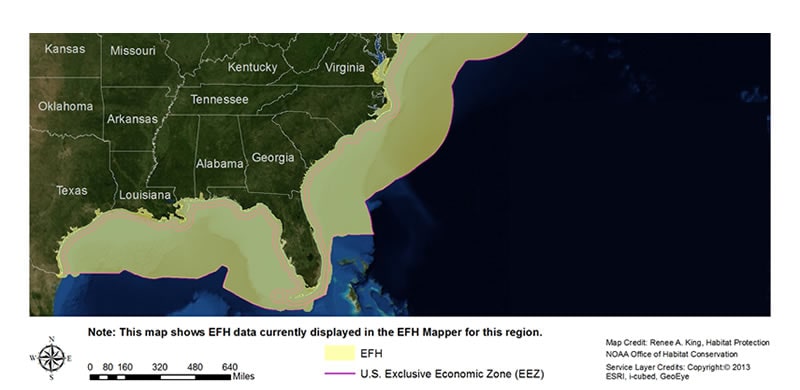
Where to fish for Bluefin Tuna
Atlantic Bluefin Tuna migrate between there spawning grounds either in the Gulf of Mexico or the Mediterranean Sea. As they travel back and forth between the North Carolina coast and the Gulf of Mexico you can target this fish anywhere between 40 to 70 miles offshore in the summer and a mile or two from the coast during the beginning of winter. When the water is warmer they like to hang out deeper at depths between 180 to 280 feet. When the water is cooler than 75 degrees they tend to feed on the surface closer to shore in water as shallow as 50 feet. Keep a lookout for seabirds circling and schools of baitfish jumping out of the water and skipjacks or albies swimming nearby. Contour structure water temperature and water clarity are all determining factors that should be taken into account. Look for offshore seamounts valleys, high spots or sudden changes in depth between Key Largo and Marathon. On February 10, 2018, a 600 pound Atlantic Bluefin was caught in 50 feet of water in a reef off Islamorada. Most Florida charters that target Bluefin Tuna are multi-day trips to the eastern edge of the Gulf Stream. Going with a captain that has experience in catching Bluefin will help you to learn the best spots, equipment, and fishing methods required to catch them.
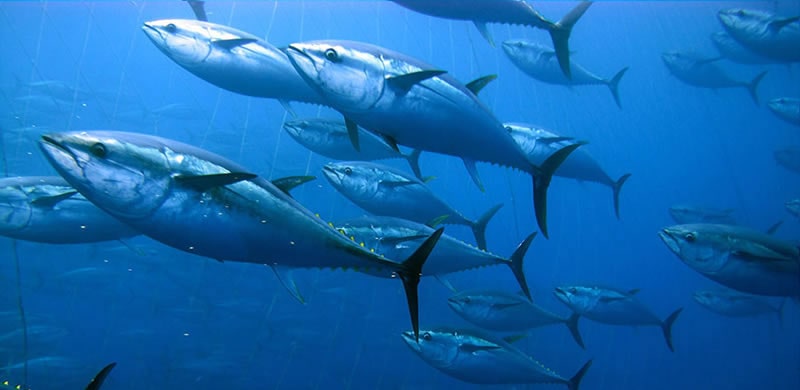
Best time of the year to fish for Bluefin Tuna in Miami
Every spring, they migrate back to their spawning grounds so this is one of the best time to fish for Bluefin in Florida offshore. They travel from the coast of Maryland down to the Gulf of Mexico. In the summertime, they feed closer to the surface making them easier to find and catch. During Winter and Spring are great times of the year to fish for Bluefin in Florida. but the best time to catch them is from July to October.
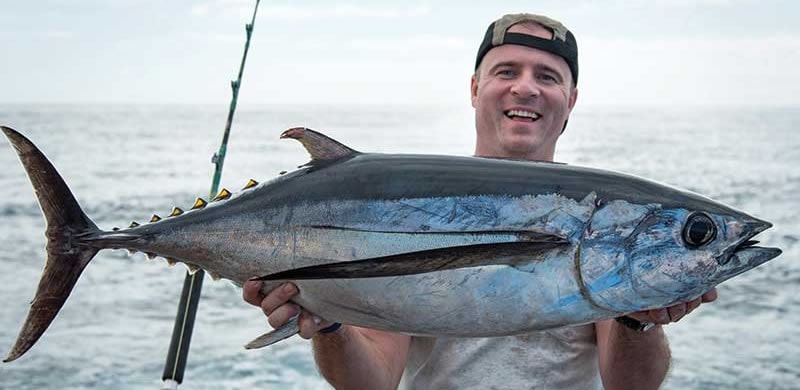
The best bait to catch Bluefin Tuna
From the moment they’re born these voracious predators are busy seeking out schools of fish like herring, mackerel, squid, sardines, little tunny, sanddabs, anchovies, flying fish, shrimp, surfperches and even eels. They have excellent vision and hunt by spotting fish from far distances. They have the sharpest vision of any bony fish so choosing the right bait is crucial. The best bait to choose is whatever baitfish are in the area. If you don’t have access to live bait you can also catch bluefin tuna by trolling with rigged natural baits or artificial lures. Due to there extremely good vision its important to hide the hook by inserting it into the mouth of the bait, pulling it three-quarters of the way out the gills, then turning it 180 degrees to re-enter the bait and push the point just enough to barely pierce the other side so that the hook is hidden by the gill plate. If you want the baits to go deeper in the water column then you can slide a 5- to 8-ounce egg sinker above the swivel, or loop a rubber band on the line to attach a bank sinker. If you’re trolling with artificial lures then you can use a variety of lures such as blue-and-white Islanders, black-and-purple skirts, tuna birds, squid spreader bars, daisy chains, and cedar plugs. If your jigging then it’s common for anglers to use Shimano Butterfly jigs or Williamson Benthos jigs. If the fish are around the boat and your casting then you should try using Yo-Zuri Bull Poppers, Yo-Zuri diving Sliders, Shimano Orca jigs, or a Williamson Popper Pro. Tunas are likely to be around forage where baitfish hide. Live bait is always king when it comes to bluefin fishing! Fresh bait will give you a definite advantage over artificial lures, but tuna more often than not prefer the real stuff.
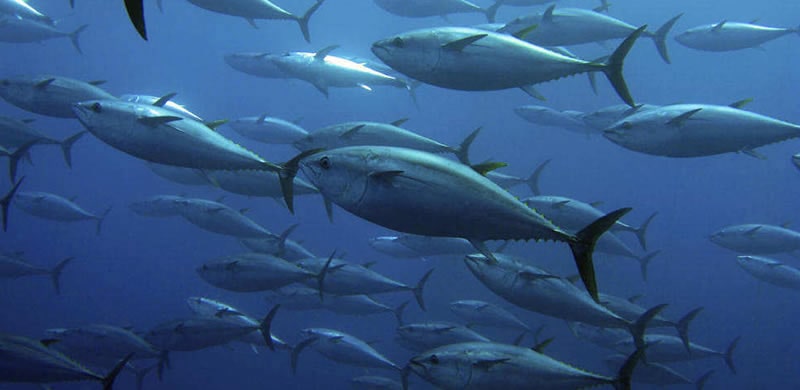
Is Bluefin Tuna good eating?
It is one of the best-eating Tuna fish in the seas and is coveted by sushi eaters around the world. Bluefin Tuna has the fattiest and darkest flesh of all the Tuna species. Sashimi-grade Bluefin is the freshest and has the highest fat content. The flesh has a firm texture and a distinctive full flavor profile. Traditionally it is served raw as sushi, sashimi, nigiri-sushi, in tartar, carpaccios or also as crudo. If your cooling it on the grill then it should be lightly seared in the same manner that you would cook a medium rare steak. Its fatty belly meat, known as ‘toro’ is one of the more expensive fish you can buy. Unfortunately, due to its great tasting flesh and large size, it has become nearly extinct in the Atlantic.
Florida Bluefin Tuna fishing regulations
Effective April 26 through December 31, 2018, the Bluefin Tuna daily retention limits for HMS Angling-permitted vessels are 2 that are between 27 inches and 47 inches and one that is between 47 inches and 73 inches. For charter boats, the maximum allowed is three that are between 27 inches and 47 inches and one that is between 47 inches and 73 inches. These limits are per vessel per day/trip are effective regardless of whether a vessel takes a two-day trip or makes two trips in one day. No more than a single day’s retention limit may be possessed, retained, or landed. Once you catch a Bluefin you must report your fish within 24 hours of catching it. if you have any other questions regarding Tuna fishing call 1-888-USA-TUNA for permits and to get answers to any questions that you may have. You can also check with the NFMS for annual daily catch limits. All bluefin tuna fisheries are regulated by the International Commission on Conservation of Atlantic Tunas (ICCAT) and managed domestically by the National Marine Fisheries Service (NMFS).












